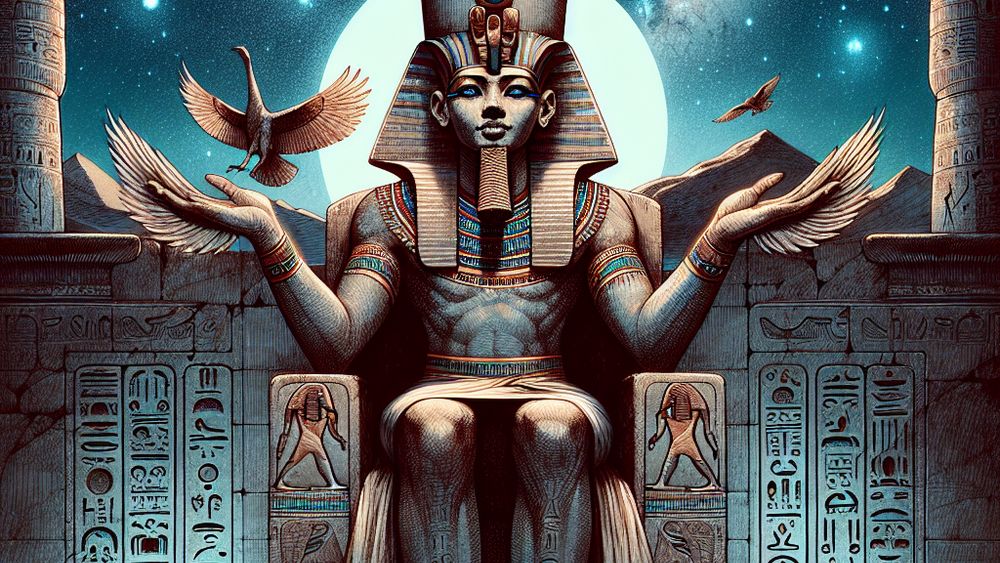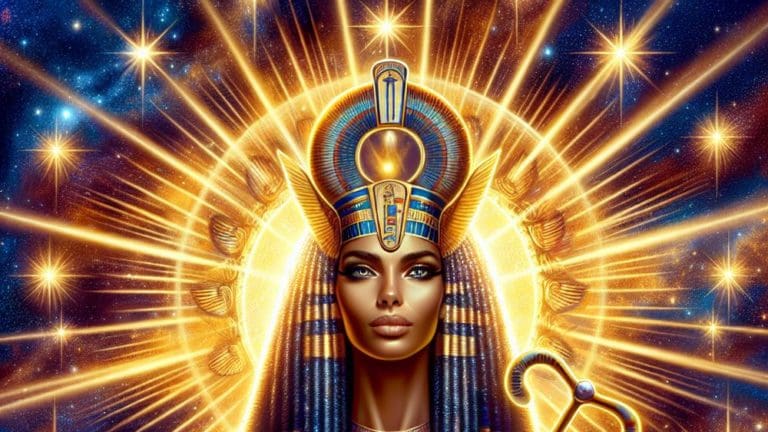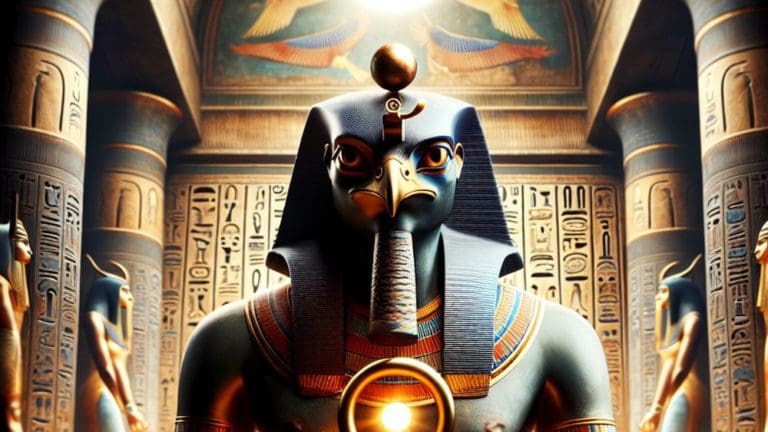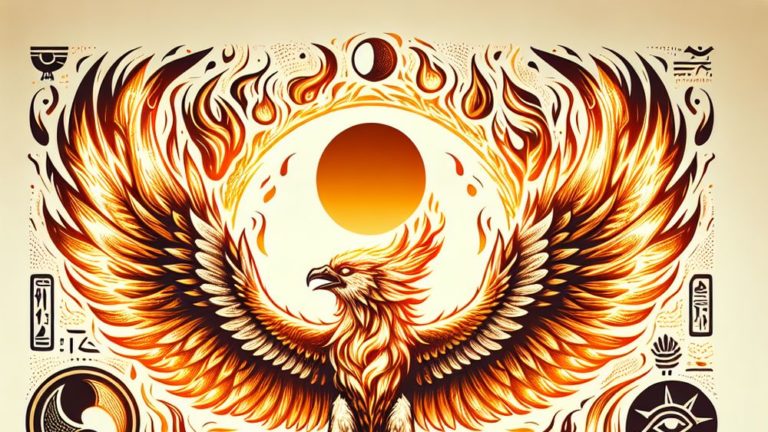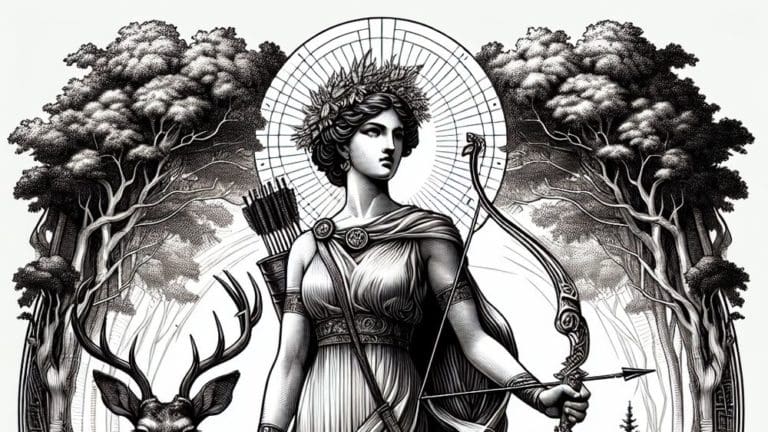Amon The Egyptian King Of Gods: Unveiling Ancient Power
Amon The Egyptian King Of Gods: Unveiling Ancient Power
Have you ever stood beneath the vast expanse of the night sky, gazing at the constellations, and pondered on the ancient gods who once ruled the imaginations and hearts of civilizations past? Among them, Amon the Egyptian king of gods stands as a towering figure, shrouded in mystery and majesty. From the sands of time, stories of his power, wisdom, and divine rulership have been etched into the very stone of Egypt, inviting us to uncover the depth of his influence.
Key Points:
- Amon, the Egyptian king of gods, rose from a local deity in Thebes to become the supreme creator and ruler of the visible and invisible.
- Amon’s elevation to king of gods was marked by absorbing attributes from other deities, culminating in the fusion with Ra to become Amun-Ra.
- The cult of Amon reached unprecedented levels of power and influence during the New Kingdom period, with priests wielding considerable political authority.
- Amon’s worship extended beyond Egypt into regions like Nubia, Libya, and the Levant, showcasing his universal appeal and influence.
- The decline of Amon’s worship occurred during Pharaoh Akhenaten’s rule, who promoted the worship of Aten, but it was later restored by Tutankhamun.
- Amon’s legacy is preserved in magnificent temples like Karnak and Luxor, reflecting his enduring significance and the intertwining of religion and state in ancient Egypt.
- Amon’s story embodies the enduring power of faith and tradition, inspiring curiosity and exploration into the mysteries of ancient Egyptian religion and culture.
Egypt itself is a land of timeless wonder, and within its bounds, Amon rose from regional deity to supreme creator, mantle of the visible and invisible. This journey from obscurity to the zenith of Egyptian religion encapsulates not just a story of one god, but of the people, politics, and priests who worshiped him. It begs the question – who really was Amon, and why did the ancient Egyptians elevate him above all other deities?
Join me, fellow history enthusiasts, amateur archaeologists, and intrepid travelers, as we embark on a captivating exploration into the heart of Thebes, delving into the origins, myths, and legacy of Amon. Let’s unravel the threads of the past, seeking answers amidst the temples and texts that have survived the aeons. Together, we’ll discover the might, mystery, and worship that surrounded Amon the Egyptian king of gods.
The Origins and Rise of Amon
The story of Amon begins in the ancient city of Thebes, now known as Luxor, which would become his thriving center of worship. As Egyptian religion evolved, so too did the stature of Amon, reflecting the changing tides of Egyptian society and politics.
The Early History of Amon
Initially, Amon was a local deity, worshipped in Thebes alongside his consort Mut and their son Khonsu. The early Thebans envisioned him as a creator god, embodying the hidden forces of life and creativity. However, Amon’s origins are shrouded in mystique, with his name meaning “The Hidden One.” Such a name encapsulates his role as a god beyond the comprehension of man, residing in the unseen realms.
Egyptian texts seldom elaborate on his initial rise, yet the Thebans held him in high regard, symbolized by his often depicted headdress featuring two tall plumes. This reverence towards Amon started to carve a distinct path for him within the pantheon of Egyptian deities, setting the stage for his ascension to prominence.
Amon’s mysterious origins and symbolic representation as The Hidden One set the stage for his eventual rise in prominence within the Egyptian pantheon.
Amon’s Ascension to King of the Gods
Amon’s ascent to the pinnacle of Egyptian religion was propelled by the political ascent of Thebes during the New Kingdom era. As Thebes rose to political power, so too did its chief god, Amon, who began to absorb attributes from other deities like Montu, the war god, and Min, the god of fertility. This amalgamation not only expanded his domain but also his following among the people and pharaohs alike.
Significantly, Amon’s elevation was marked by his association with the sun god Ra, leading to the birth of Amun-Ra. This fusion combined Amon’s mysterious might with Ra’s sovereignty over the sun and creation, culminating in a deity who was both king of the gods and the embodiment of the sun’s life-giving power. It was a masterful union of theological and political strategy, cementing Amon’s place at the heart of Egyptian religion.
This process was not merely the merging of divine aspects but also reflected the ambitious Theban priests’ efforts to elevate their god and, by extension, their city and themselves. Amon, now revered as the king of gods, became central to the state religion, with immense temples erected in his honor and his priests wielding considerable influence. It’s fascinating to consider how earthly politics and divine aspiration intertwined, elevating Amon to unparalleled heights.
The Significance of Amon in Ancient Egypt
Amon’s pivotal role in ancient Egyptian religion cannot be overstated. As the king of gods, his worship permeated every aspect of Egyptian life, from the grandiose temples that dotted the landscape to the daily prayers of the Egyptians. His significance was both a reflection of and a contributor to the identity of Egypt during its most triumphant eras.

Amon’s Creation Myths and Roles
Amon’s role in Egyptian mythology is vast and varied. Initially revered as a god of the air and the wind, his persona evolved significantly over time. As the creator of the universe, Amon was believed to exist before all things, having crafted the world and everything in it with his thoughts and words. This creation aspect intertwines him with the fabric of existence, making him a central figure in the religious and cosmological views of the ancient Egyptians.
Creation myths associated with Amon often depict him as a deity of invisible force, embodying the primordial chaos that preceded order in the universe. This concept was a powerful idea, positioning Amon as a god who transcends physical form and nature. Moreover, his role did not end with the creation; Amon remained a protector of the Egyptian people, a provider of life through his union with the sun god Ra, and a father figure to kings and commoners alike.
Amon’s evolution from a god of the air to the creator of the universe highlights the profound significance of embracing change and growth in one’s own journey.
The Cult and Priests of Amon
The cult of Amon, particularly during the New Kingdom period, reached unprecedented levels of power and influence. The priests of Amon were not merely religious figures but also key political players, wielding authority that at times rivaled that of the pharaohs themselves. They oversaw vast temples, such as the magnificent Karnak, which served not only as places of worship but also as economic centers, amassing wealth and resources critical to the maintenance and expansion of Amon’s worship.
Thebes became the epicenter of Amon’s cult, with the entire city thriving under his patronage. It was here that the most elaborate rituals were conducted, and the grandest festivals celebrated in his honor. The priests of Amon played a pivotal role in these ceremonies, acting as intermediaries between the god and his people. Their influence was so profound that they often engaged in diplomatic missions and had a significant hand in the geopolitical landscape of the New Kingdom.
Amon’s Relationship with Other Gods
As Amon rose to prominence, his relationships with other Egyptian deities underwent significant transformations, absorbing and merging with other gods to reflect his evolving character and expanding worship.
Amon and the Ogdoad
Before Amon’s ascent, the city of Hermopolis was known for its Ogdoad – a group of eight deities representing the primordial elements of creation. Amon’s connection to these gods further reinforced his status as a creator deity, weaving his story into the very fabric of the universe’s creation mythology. The Ogdoad’s concepts of chaos and formlessness were attributes that Amon, as “The Hidden One,” naturally encompassed, embodying the unseen forces of life and the mystery of creation.
Amon’s integration into this older, established pantheon showcases the adaptability and syncretism inherent in ancient Egyptian religion. As Amon incorporated aspects of the Ogdoad into his worship, he didn’t simply overshadow these deities; rather, he absorbed their essential qualities, reinforcing his image as a god beyond mere sun or air, spanning the entire cosmos. This association imbued Amon with an aura of primordiality and universality, elevating him above the realm of other gods and directly linking him with the creation and maintenance of the universe.
The Fusion of Amon and Ra: The Birth of Amun-Ra
The fusion of Amon and Ra into Amun-Ra signifies one of the most monumental transformations in the pantheon of Egyptian deities. This pivotal event occurred during the New Kingdom, a period marked by unparalleled prosperity and religious reform. Ra, the sun deity, had long been venerated as the king of gods and represented the sun’s life-giving power. Amon, initially a somewhat obscure local god of Thebes, gradually rose in prominence, his name becoming synonymous with the hidden and the mysterious. The blend of these two powerful entities created Amun-Ra, a deity that symbolized both the visible and invisible forces of the universe.

Amun-Ra came to embody the ultimate power of creation, merging the sun’s massive energy with the mysterious forces governing life and death. Egyptians revered Amun-Ra as the supreme creator deity, from whom all existence flowed. The amalgamation of Amon and Ra didn’t just signify a religious and mythological fusion but was a strategic move that solidified Thebes as the religious center of Egypt. It underscored the city’s political and spiritual ascendancy, making Amun-Ra the patron of pharaohs and the state.
The worship of Amun-Ra extended far beyond the confines of Thebes, impacting neighboring regions and altering the religious landscape of the area. This fusion of deities shows the flexible nature of Egyptian religion, where deities could merge or separate, adapting to the changing cultural and political climates. Amun-Ra’s temples became sites of immense religious significance, drawing priests, worshippers, and pharaohs alike, all seeking the favor of this powerful sun god. This deity’s role in creation myths and daily religious life highlights the Egyptians’ profound relationship with the divine, where gods were both abstract and imminently present in the fabric of the world.
The Worship and Temples Dedicated to Amon
The worship of Amon, especially following his fusion with Ra, was not only a spiritual practice but also a testament to the Egyptians’ remarkable architectural prowess. The temples dedicated to Amun-Ra, the king of gods, stand as enduring monuments to the deity’s immense power and the central role he played in Egyptian religion. These temples were not just places of worship; they were complex centers of economic, political, and cultural activity, where priests played pivotal roles in maintaining the cosmic order on behalf of the people and pharaohs.
The Theban Centre of Worship
At the heart of Amon’s worship was the city of Thebes, a place that became synonymous with the deity himself. As Amon’s influence grew, so too did the grandeur of Thebes. It transformed into a bustling metropolis, a center for religion, culture, and politics. The city was home to Karnak and Luxor, two of the most significant temple complexes not just in Egypt but in the entire ancient world.
Karnak, particularly, represented the zenith of devotion to Amon, housing a vast array of chapels, obelisks, and statues, all dedicated to various gods within the Egyptian pantheon, but primarily to Amon-Ra. Festivals, particularly the festival of Opet, saw the gods’ statues paraded between Karnak and Luxor, a vivid public demonstration of religious fervor. These ceremonies played a crucial role in reinforcing the bond between the deities, the pharaohs, and the people, symbolizing the divine favor upon which the state’s prosperity depended.
The grandeur of Thebes as a bustling metropolis centered around Amon’s worship played a crucial role in reinforcing the bond between deities, pharaohs, and the people, symbolizing the prosperity of the state.
Key Temples and Their Significance
Among the sprawling sands of Egypt stand two temples, Karnak and Luxor, which serve as beacons of the past, dedicated to the worship of Amon. Karnak, the larger of the two, is often considered the most significant religious building ever constructed. It is a complex of sanctuaries, kiosks, pylons, and obelisks dedicated to the pantheon of Egyptian gods but chiefly to Amun-Ra. Its grandeur and architectural innovation reflect the deity’s prestige and power.
Luxor Temple, though smaller, is no less significant. It was primarily associated with the rejuvenation of kingship; pharaohs were believed to be reborn there during the coronation ritual. This role in the creation and maintenance of royal power highlights the political importance of religious practice and the king-deity relationship in Egyptian culture. Together, these temples illustrate the interwoven nature of religion and state, the architectural mastery of the ancient Egyptians, and the enduring legacy of their belief in the power and protection of the gods.
Amon’s Influence Beyond Egypt
The influence of Amon, especially in his form as Amun-Ra, extended far beyond the borders of Egypt, reaching into Nubia, Libya, and even the Levant. This spread of worship signifies not just the religious significance of Amon but also the political and cultural impact of Egypt on neighboring regions. Through military conquests, trade relations, and diplomatic endeavors, the cult of Amon found receptive audiences far and wide, integrating itself into various religions and influencing local deities. This expansion illustrates the deity’s universal appeal and the ancient Egyptians’ profound influence on the spiritual landscape of the ancient Near East.
Amon in Nubia and Libya
In Nubia and Libya, the worship of Amon took on distinct characteristics that reflected the regions’ own cultural and religious landscapes. In Nubia, particularly, Amon was revered as a creator god and protector of the Egyptianized kingdom of Kush. Nubian pharaohs, ruling from the city of Napata, embraced Amon fervently, building magnificent temples in his honor, such as the one at Jebel Barkal, which became a center for Amon’s worship outside Egypt.
In Libya, meanwhile, Amon was assimilated into local traditions, becoming a deity of fertility and creation, mirroring his aspects in Egyptian tradition. Libyan princes and rulers who had connections with the Egyptian court often adopted the worship of Amon, further cementing the cultural and political ties between Egypt and Libya. This blend of religious practices underscores the adaptability of Amon’s worship and its appeal across different cultures and peoples.
The Spread of Amon’s Cult to the Levant
The spread of Amon’s cult to the Levant through trade, military conquests, and political alliances showcases the transcultural exchange between Egypt and its neighbors. In the Levant, Egyptian deities, particularly Amon, were often worshipped alongside local gods, indicating a syncretism that was common in ancient religions. The Phoenicians, known for their maritime prowess, played a significant role in disseminating the cult of Amon, adopting elements of his worship into their own religious practices.
This syncretism was not just a mere blending of deities but a reflection of the dynamic cultural interactions between ancient civilizations. Amun-Ra’s name was invoked in treaties and declarations, signifying his importance as a protector and guarantor of oaths. The presence of Amon in the Levant also underscored the geopolitical influence of New Kingdom Egypt, as pharaohs sought to extend their religion and culture beyond their empire’s traditional boundaries.
The syncretism of Egyptian and local deities in the Levant reflects dynamic cultural interactions between ancient civilizations.
The Decline of Amon’s Worship
The decline of Amon’s worship, particularly during the reign of Pharaoh Akhenaten, stands as a profound shift in Egyptian religious practices. Akhenaten’s establishment of Aten as the sole god marked a radical departure from Egypt’s traditional polytheistic religion, directly challenging Amon’s supremacy. Temples were closed, priests displaced, and images of Amon were defaced, as Akhenaten sought to erase the god’s influence. This period of religious upheaval, while brief, underscores the tumultuous relationship between faith and power in Egyptian society, where gods could rise and fall with the fortunes of pharaohs.
The Challenge by Pharaoh Akhenaten
During the New Kingdom period, a monumental upheaval challenged the very foundation of Egyptian religious practices. Pharaoh Akhenaten, in a revolutionary move, shifted the empire’s traditional polytheistic beliefs towards the worship of a single deity, Aten, the sun disc. This radical transformation not only relegated Amon, the king of gods, to the sideline but also upended centuries of religious tradition and practices.
Akhenaten’s religious reforms were as radical as they were swift, dissolving the powerful priesthoods associated with Amon and other gods and redirecting the state’s wealth and resources towards the Aten’s singular worship. Cities like Thebes, which had been the heart of Amon’s worship, witnessed a decline in their spiritual and economic standing, as Akhenaten established a new religious center at Amarna.
Despite these efforts, Akhenaten’s revolution had a palpable tension. The people of Egypt, deeply rooted in their traditional beliefs and practices, found it difficult to adapt to this abrupt shift in worship. The loyalty towards Amon, ingrained over millennia, posed a silent but formidable resistance to Akhenaten’s monotheistic agenda, setting the stage for a remarkable religious revival following the pharaoh’s death.
The Restoration and Continued Popularity of Amon
Following Akhenaten’s reign, a concerted effort was made to restore the former glory of Amon’s cult. Tutankhamun, Akhenaten’s successor, played a pivotal role in this restoration, moving the capital back to Thebes and reinstating the worship of Amon and the traditional pantheon of Egyptian gods. This period saw a rejuvenation of the religious, cultural, and architectural achievements associated with Amon’s worship.
The priesthoods of Amon, once displaced, were reestablished with even greater authority and resources. Priests once again became key figures in Thebes, rebuilding temples and statues that had been destroyed or defaced during Akhenaten’s reign. The people’s devotion to Amon as the king of gods was reignited, securing his place as a central figure in Egyptian religion.
Amon’s restored popularity wasn’t just a return to the status quo but marked an enhancement of his divine position. Amun-Ra, the fusion of Amon with the sun god Ra, emerged as an embodiment of universal power, underscoring Amon’s supreme status among the deities. This consolidation of divine power served not only to strengthen the bond between the people and their gods but also to solidify the pharaohs’ claim to divine right and kingship, echoing throughout the New Kingdom and beyond.
FAQs
1. How did Amon become the king of gods in Egyptian mythology?
In Egyptian mythology, Amon became the king of gods by gradually rising in importance and merging with Ra, the sun god, becoming Amun-Ra. This fusion represented a unification of hidden power (Amon) and the visible power of the sun (Ra), elevating him as the chief deity in the pantheon.
2. What are the key symbols associated with Amon?
The key symbols associated with Amon include the ram, representing fertility and war, and the two vertical plumes he wears on his headdress. These symbols reflect his dual nature as a deity of the wind and a king of the gods.
3. How did Amon’s worship influence other cultures?
Amon’s worship influenced other cultures, especially in Nubia and the Levant, where his cult spread through political and commercial interactions. His universal aspects as a creator and king of the gods made him appealing to a wide audience, integrating him into local religions.
4. What led to the decline of Amon’s worship in ancient Egypt?
The decline of Amon’s worship in ancient Egypt was primarily due to the religious revolution led by Pharaoh Akhenaten, who promoted the worship of Aten, sidelining Amon and other deities. However, Amon’s worship was later restored, highlighting his enduring significance.
Conclusion
The story of Amon, from his origins to the challenges he faced and the ultimate resurgence of his cult, paints a vivid picture of the religious dynamics in ancient Egypt. Amon the Egyptian king of gods not only survived the test of time but also emerged stronger, etching his name into the annals of history as a testament to the enduring power of faith and tradition. His legacy, encapsulated in magnificent temples and passionate worship, continues to fascinate and inspire those who are drawn to the mysteries of the past.
To delve deeper into the enigmatic world of ancient deities and uncover the tales of divine power and human faith is a journey like no other. May the story of Amon fuel your curiosity and encourage you to explore the rich tapestry of ancient Egyptian religion and culture.
Until next time, keep exploring and questioning the mysteries that history has to offer.
Warm regards,
Cedric

